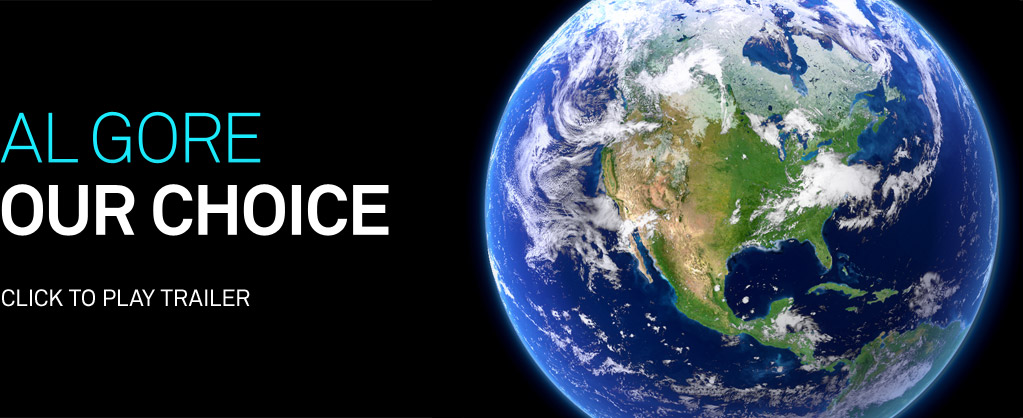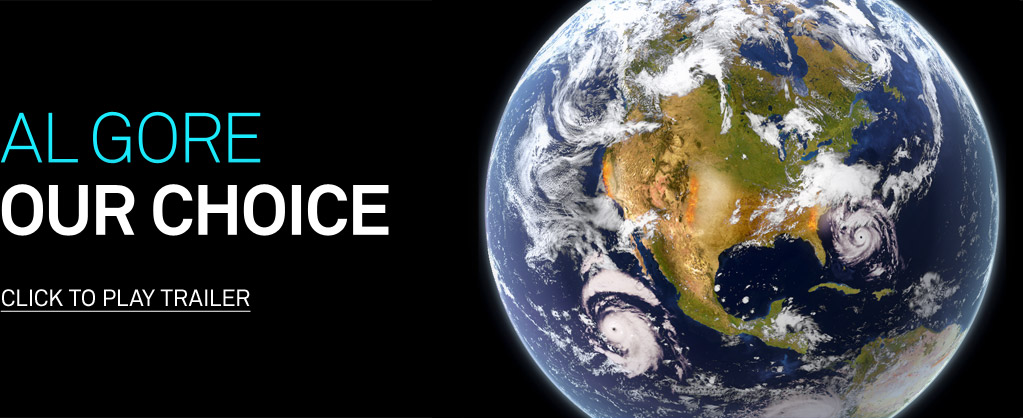

Our Choice will change the way we read books. And quite possibly change the world. In this interactive app, Al Gore surveys the causes of global warming and presents groundbreaking insights and solutions already under study and underway that can help stop the unfolding disaster of global warming. Our Choice melds the vice president's narrative with photography, interactive graphics, animations, and more than an hour of engrossing documentary footage. A new, groundbreaking multi-touch interface allows you to experience that content seamlessly. Pick up and explore anything you see in the book; zoom out to the visual table of contents and quickly browse though the chapters; reach in and explore data-rich interactive graphics.
Al Gore demonstrates the groundbreaking features that make Our Choice the first full-length interactive book of its kind.
Our Choice includes more than 270 images by some of the world's finest photographers and photojournalists. The photos reveal the sources of global warming, survey where our energy comes from, and show off how solutions to the climate crisis are coming into focus. They are the visual backbone of the reading experience and depict people and locales in every corner of the globe with artfulness and unflinching clarity.
Photos throughout the app feature original audio commentary by Al Gore, describing his own experiences and perspectives, conveying new information, and adding historical and social context to the images.
Our Choice contains 35 short movies that comprise more than an hour of documentary footage. The videos include compelling introductions to the roots of the climate crisis, historical footage, and interviews with green pioneers such as food activist Michael Pollan and atmospheric scientist Charles Keeling. In addition, 15 original animations show how natural systems, energy technologies, and proposed solutions work.
Zoom in and explore every image's location on an interactive map. Our Choice visits every corner of the earth, revealing where global warming pollution comes from, and where people are taking action.
Fifteen interactive graphics — from a multilayered history of oil prices to a changeable demonstration of how a passive-solar home works to a windmill powered by your own breath — bring static information to life.
Our Choice is the result of the groundbreaking insights offered by the participants in more than 30 intensive "Solutions Summits" organized to construct strategies for solving the climate crisis. This multimedia book is meant to inspire readers to take action — as individuals and as participants in the political process — and meet the challenge that now confronts us.
The deterioration of our atmosphere is by far the most serious manifestation of the worldwide ecological crisis. It affects every part of the earth, and if it is not quickly addressed, it has the potential to end human civilization as we know it. For all its complexity, however, its causes are breathtakingly simple.
Accelerated development of low-CO2 substitutes for energy production is urgently needed. The exciting news about such sources of energy is that there is an almost limitless amount available. Indeed, all of the oil, coal, and natural gas in the world contain the same amount of energy as the earth receives in only 50 days from the sun.
Once the world chooses to set ambitious goals for scaling up solar-electricity development and commits to the investments necessary to further improve the technologies involved, there is no question that solar energy will provide a major percentage of the world's electricity.
Not only is wind the fastest-growing source of renewable electricity, but it is the fastest-growing source of any form of energy, surpassing the net additional capacity from coal-fired, gas-fired, and nuclear power plants combined. Wind energy's widespread availability is a main reason it has become the world's most popular new source of electricity.
MIT estimates that the "technically extractable portion" of the U.S. geothermal resource is "about 2,000 times the annual consumption of primary energy in the United States." Indeed, geothermal sources could provide a significant fraction of U.S. primary energy needs in a sustainable manner for electricity generation and for the heating and cooling of buildings.
Because of the energy consumed in transforming plant material into a usable form of power, the benefits of biomass energy often still outweigh the costs, but full "life cycle" analyses may soon determine which approaches are truly beneficial in solving the climate crisis.
All the technologies for capturing, compressing, transporting, and sequestering CO2 emissions have been developed and tested on a small scale. All of them work. But the components have yet to be integrated and implemented on a large scale. Changing this situation constitutes one of civilization's main challenges for solving the climate crisis.
In the world's debate over how to produce electricity without generating massive quantities of greenhouse gas pollution, there is a radioactive white elephant in the room: nuclear power, an energy source in crisis for the last 30 years. Can the obstacles to the once hoped-for expansion of nuclear power be overcome?
Deforestation has a double impact on the climate: first, most of the carbon contained in the trees is emitted into the atmosphere; and second, the planet loses part of its ability to reabsorb CO2. The good news is that governments are making efforts to sharply reduce deforestation — though the key to success will be addressing its underlying causes.
By changing our land use patterns, we can not only reduce emissions of CO2, methane, and nitrous oxide, but we can also pull a significant percentage of the CO2 in the atmosphere into the soils, where much of it can be sequestered for hundreds or even thousands of years.
The world's effort to stabilize population growth — a crucial factor in solving the climate crisis — is a historic success story, albeit in slow motion. Indeed, the question of how to stabilize population is, by and large, one of the rare questions around which there is a global consensus. Now we must capitalize on this emerging success.
Improvements in the efficiency with which we use energy are far and away the most cost-effective among the solutions to the climate crisis and can be implemented quickly. The opportunities for enormous gains can be found in every sector of the economy—industrial processing, residential and commercial buildings, transportation, even in the design of cities themselves.
Improving electricity-delivery systems by constructing continent-wide unified smart grids — or super grids — will significantly reduce the huge emissions of global warming pollution caused by inefficiencies and failures in the transmission, distribution, and storage of energy. The technologies necessary to build a super grid are all fully developed and available now.
Global warming has been described as the greatest market failure in history. It is also the biggest failure of democratic governance in history. In searching for the underlying reasons for this, psychologists and neuroscientists have begun to argue that the climate crisis poses an unprecedented challenge to our ability to use reason as a basis for urgent response.
Carbon dioxide, the most important source of global warming pollution, is invisible, tasteless, and odorless. It is largely invisible to market calculations as well. And when something's not recognized in the marketplace, it's easier for government and business to pretend it doesn't exist. That's got to change.
John Kenneth Galbraith once quipped, "Politics is not the art of the possible; it is the art of choosing between the disastrous and the unpalatable." In the case of the climate crisis, our choice has been clouded by confusion, generated in large part by a massive political campaign of intentional deception on the part of many corporate carbon polluters.
Now that we are faced with the unprecedented challenge of rapidly improving our understanding of the earth's ecological system and our place in it, it is time to focus on how we can make the fullest and most creative use of information technology to help us.
Not too many years from now, a new generation will look back at us and pose one of two questions. Either they will ask, "Did you hear the warnings and just not care?" Or they will ask instead, "How did you find the moral courage to rise up and solve a seemingly unsolvable crisis?" We must choose which of these questions we want to answer, and we must give our answer now.

iPad, iPhone, and iPod Touch
Tweet